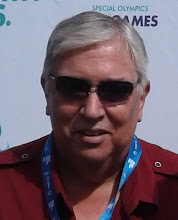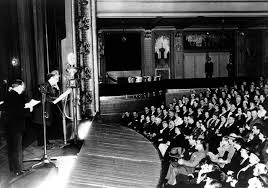Marriage As He Knows It: The Way It Was, 26 March
1907---Writer Philip Rapp is born today. Whether his signature old-time radio creation will be considered the opening salvo of the liberation of realism or the first broadcasting stink bomb thrown into the ideal of matrimony will depend almost entirely upon the viewpoint of those who listen to it.
He will already have sent radio its meanest widdle kid (developing her out of a semi-regular routine performed by a woman old enough to be her mother in the first place) when his own marital squabbling finds a tension release in his creation of the couple who become, arguably, broadcasting's patron saints of connubial caterwauling: John and Blanche Bickerson.
Radio couples have not exactly been immune to the periodic spat by the time these two arrive first as a sketch on The Chase and Sanborn Show. Jane Ace's malapropping meddling has driven her husband to distraction if not to drink on numerous occasions. There's a reason why another popular radio wife earns the sign-on line, "That's Molly Goldberg, with a place in every heart---and a finger in every pie." The Rileys aren't always blunt sweetness and light, not whenever oafish but bighearted husband Chester can't keep from trying to improve things by making them worse before they get better. And even Wistful Vista's McGees are known for the occasional spat, usually ending when yet another of McGee's hair-brained ideas requires a trip back to earth guided by patient wife Molly.
Along come the couple John Crosby will tag immortally as the Bickering Bickersons, first on The Chase & Sanborn Show (hosted by Edgar Bergen and Charlie McCarthy), then on Drene Time (nominally a variety show), and finally on their own fifteen-minute slot. (The tag will fit so properly that people will come to think that's actually the name of the show.) Technically, their sum radio life is barely beyond two years (they're not exactly a regular showing), but aesthetically they far outlive their air time. And they'll make Jiggs and Maggie, the air couple to whom they're compared most often in their day, resemble Ozzie and Harriet.
Blanche, played very capably by Frances Langford, is one of the monstrous shrews of all time. She makes her husband Don Ameche take two jobs, a total of sixteen working hours, in order to bring in more money which she squanders on minks and the stock market. Meanwhile, he can't afford a pair of shoes and goes around with his feet painted black. In the few hours he has to sleep, she heckles him all night with the accusation that he doesn't love her. Her aim appears to be to drive her husband crazy and she succeeds very nicely. The harassed John's only weapon is insult, at which he's pretty good . . . Bear in mind that this is 2 a.m. and John is trying throughout to get to sleep.---John Crosby, "The Bickering Bickersons," New York Herald-Tribune, 25 May 1948, republished in Out of the Blue: A Book About Radio and Television. (New York: Simon and Schuster, 1952.)
"There was so much sweetness," Philip Rapp will say in 1980, decades after his signature creation leaves the air, referring to the success of such affirmative radio couples as Ozzie and Harriet, Jim and Margaret Anderson on Father Knows Best, Phil Harris and Alice Faye, Ethel & Albert, the Rileys to a point, the McGees to a greater point, and even George Burns and Gracie Allen, if you thought about it hard enough. "This was not marriage as I knew it."
How he knows marriage will get, perhaps, its best short summary from his own son, Joel, in due course: "I've hidden under a lot of tables in my day." (Joel Rapp will add that his father would rush to the typewriter as soon as he could after such squabbles ended.)
The idea of suave Don Ameche and sexy, honey-voiced singer/actress Frances Langford paired up as a couple whose sole passion in life is domestic blitz seems just as absurd as the premise that a young enough married couple, who aren't otherwise mired in the working poor's rut, have, apparently, nothing much in common save a taste for trying to see just how long a hassled husband ---whose trademarks include a chainsaw-volume snore punctuated by a fluctuating series of whimpers, whines, whoops, and giggles---can stand it before he finally knocks his hassling wife into the middle of next year.
To that crime no jury, even in politically correct times and extremes, will claim him unjustified, so long as even one recording of John and Blanche's overnight debates (and we use the term with extreme looseness) is played in evidence before the court.
BLANCHE: I keep thinking how nice it was before we were married.
JOHN: Mmmmm-hmmm!.
BLANCHE: You were so different then. You used to plead with me for a little kiss. Now, you don't even think of it. Why?
JOHN: A mouse in the trap loses his taste for cheese..----------------BLANCHE: I'm a nervous wreck. I've got crow's feet around my eyes. My forehead's all wrinkled, my chin is sagging, I'm beginning to look like an hold hag. (Pause.) It's true, isn't it?
JOHN: (quietly) I wouldn't say that.
BLANCHE: Why not, John?
JOHN: I'll be awake for the rest of the night.
BLANCHE: You do think it's true, though, don't you?
JOHN: What's true?
BLANCHE: I'm beginning to look like an old hag.
JOHN: You are not beginning to look like an old hag.
BLANCHE: Why do you emphasise "beginning"?
JOHN: All right---you are not beginning to look like an old hag.----------------BLANCHE: You used to be so considerate. Since you got married to me, you haven't got any sympathy at all.
JOHN: I have, too. I've got everybody's sympathy.
Thus the inspiration for such television tusslers as the Kramdens, the Bunkers, and the Bundys, all of whom owe more than some of their vituperation to the dissatisfied wife whose life work seemed to be keeping her husband from obtaining a decent night's sleep without at least three hours' warfare launched at two every morning.
Perhaps the only true crimes of The Bickersons are two, when all is said and done:
1) Because it is, essentially, barely more than a one-note can of domestic whoopass that often recycles particular punch lines (as opposed to the running gag), The Bickersons isn't destined to a very long air life, even if it is destined to a long afterlife in the hands of radio collectors.
2) One of the better (and underrated) big band singers of the 1940s, whose honey contralto is underwritten by a suggestive sense of swing, is doomed to be remembered barely for her music and almost entirely as the biggest nag in America this side of the horse on which Blanche was fool enough to bet with the rent money. Perhaps appropriately, the horse wins the race---but she thinks Disqualified is his name.
CHANNEL SURFING . . .
1946: PIERRE THE DESIGNER---A fashion designer wants Blackie's (Dick Kollmar) help proving his innocence of the theft of his IOU and cash from a creditor's safe---a theft Faraday (Frank Orth) is convinced Blackie alone could have pulled, especially when Mary (Jan Miner) turns up with six new dresses from the designer's collection, on tonight's edition of Boston Blackie. (Syndicated.) Writers: Kenny Lyons, Ralph Rosenberg.
1947: DEDICATED TO AMERICA'S LANDLORDS---Who may or may not necessarily be thrilled at the satirical grilling and chilling they're going to get, after (Henry) Morgan, Arnold (Stang), and company wonder whether or not to assume "real" characters for themselves, on tonight's edition of The Henry Morgan Show. (ABC.) Additional cast: Betty Garde, Charles Irving, Madaline Lee. Music: Bernie Green Orchestra. Writers: Henry Morgan, Carroll Moore, Jr., Aaron Ruben, Joe Stein.
PREMIERING TODAY . . .
1894---Will Wright (actor, Fibber McGee & Molly, My Little Margie), San Francisco.
1908---Hank Sylvern (conductor: Beyond Tomorrow)
1916---Sterling Hayden (actor: We the People), Montclair, New Jersey.
1918---William Hardcastle (newscaster: The World at One), Newcastle, U.K.
1923---Bob Elliott (comedian: Matinee with Bob & Ray, Bob & Ray Present the CBS Radio Network, The Bob & Ray Show), Boston.
1924---Marcia Van Dyck (actress: It's The Barrys), Grants Pass, Oregon.
1908---Hank Sylvern (conductor: Beyond Tomorrow)
1916---Sterling Hayden (actor: We the People), Montclair, New Jersey.
1918---William Hardcastle (newscaster: The World at One), Newcastle, U.K.
1923---Bob Elliott (comedian: Matinee with Bob & Ray, Bob & Ray Present the CBS Radio Network, The Bob & Ray Show), Boston.
1924---Marcia Van Dyck (actress: It's The Barrys), Grants Pass, Oregon.
R.I.P.
HERMAN STEIN---91; composer who wrote and arranged for assorted radio programs in the 1930s and 1940s, before graduating to arranging for Count Basie, Fred Waring, and Bob Crosby and their orchrstras and, far more notably, scoring horror and science fiction film hits The Creature From The Black Lagoon and The Incredible Shrinking Man. Heart failure, Los Angeles.
Stein's first known film composing assignment tied to old-time radio, however: he wrote the music for 1952's Here Come The Nelsons, a film Ozzie and Harriet Nelson made largely to prove to ABC that their radio family might be viable as a television presence.
Born and raised in Philadelphia, Stein's believed to have taught himself to write and arrange music by studying scores in the public library collection. A staff composer for Universal Pictures, Stein went uncredited for the most part during that period, given the studio's then-policy of giving composing credit to the music supervisor while several composers at a time might be assigned to a film. Stein also composed music for two popular film series, Ma and Pa Kettle and Francis, the Talking Mule.












0 Comments:
Post a Comment
Subscribe to Post Comments [Atom]
<< Home